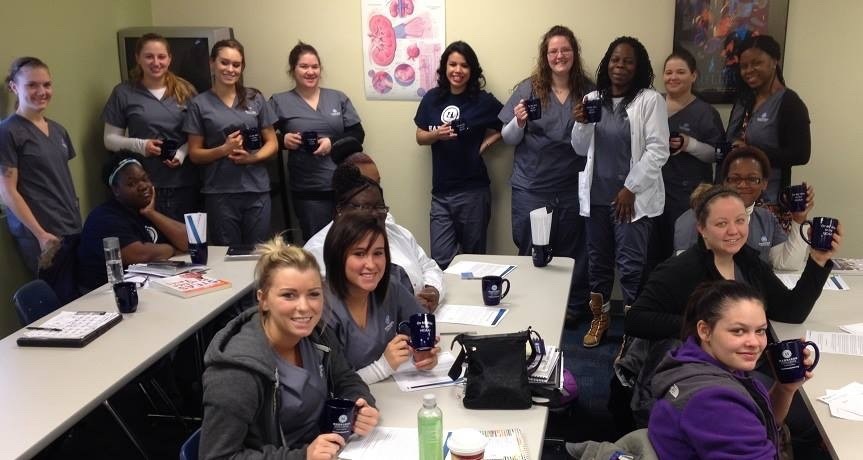Are you passionate about healthcare and eager to start a rewarding career that directly impacts patient care? Then becoming a medical assistant could be the perfect path for you!
This career is one of the fastest ways to break into the industry. In fact, all you need is a certificate or diploma to get started! If you find you like this job, you might even consider pursuing a BSN or alternative nursing career later on.
For now though, let’s explore how to become a medical assistant, why you should, and how much you can expect to make.
Table of contents
- What Is A Medical Assistant?
- What Does A Medical Assistant Do?
- Why Should You Become A Medical Assistant?
- How To Become A Medical Assistant
- How Long Does it Take to Become a Medical Assistant?
- How Much Does it Cost to Become a Medical Assistant?
- Best Online Medical Assistant Programs
- How Much Does a Medical Assistant Make?
- Conclusion
What Is A Medical Assistant?
A medical assistant is responsible for both clinical and administrative tasks in medical offices, clinics, and hospitals. This dual-role ensures the smooth operation of healthcare facilities and enhances the overall patient experience.
Their responsibilities typically include:
- Assisting physicians in patient examinations
- Recording patient histories
- Managing appointments
- Handling billing and coding
With a mix of hands-on clinical work and office tasks, medical assistants are key to bridging the gap between patients and physicians.
What Does A Medical Assistant Do?
A typical day for a medical assistant is dynamic and multifaceted, as they’re responsible for both administrative and clinical tasks.
It’s important to note that the exact duties and responsibilities of a medical assistant can vary depending on the healthcare setting.
For example, in larger facilities, medical assistants may have more specialized roles. Meanwhile, in smaller practices, they may be responsible for a broader range of tasks.
Regardless of the specific responsibilities, medical assistants play a crucial role in delivering patient-centered care and ensuring the smooth operation of healthcare practices.
Here’s an overview of what a day-to-day routine for a medical assistant might look like.
1. Preparing for the Day
Medical assistants typically start their day by arriving at the healthcare facility a bit earlier than other staff to ensure everything is ready for patient appointments.
Then they may review the schedule to see which patients are coming in and what types of appointments they have (e.g., check-ups, vaccinations, or procedures).
2. Administrative Duties
As patients arrive, medical assistants often greet them, check them in, and verify their personal and insurance information.
They may also assist with scheduling future appointments, including referrals to specialists or diagnostic tests. Throughout the day, medical assistants may answer patient phone calls and address prescription refill requests.
Finally, they maintain and update patient records ensuring all information is accurate and up-to-date. They might even assist with insurance claims, verify patient coverage, and help patients understand their insurance benefits.
3. Clinical Duties
One of the primary clinical responsibilities of a medical assistant is taking vital signs, including:
- Blood pressure
- Heart rate
- Temperature
- Respiratory rate
They also record these measurements in the patient’s chart, as well as gather medical histories, including information about current symptoms and medications.
Additionally, they escort patients to examination rooms, prepare them for the physician or nurse practitioner, and assist with any necessary procedures. During examinations, medical assistants may help with procedures, provide instruments or supplies, and offer support to the healthcare provider.
In some states, medical assistants with proper training and certification may even administer medications, including injections.
Other clinical duties might involve:
- Specimen Collection: Collecting and labeling specimens for laboratory testing and ensuring that they are properly stored and transported.
- EKGs and Other Tests: Performing electrocardiograms (EKGs) and other diagnostic tests as required.
- Patient Education: Providing patients with information about medications, treatment plans, and self-care instructions.
4. Clean-Up and Sterilization
After each patient encounter, medical assistants ensure that examination rooms are cleaned, sanitized, and properly stocked with supplies.
They must follow strict infection control protocols to maintain a safe and hygienic environment.
5. End-of-Day Responsibilities
At the end of the day, medical assistants may assist in closing the clinic or office, ensuring that all records are properly filed, and equipment is cleaned and stored.
They may also prepare for the next day’s appointments by confirming schedules and making sure all necessary supplies are available.
6. Ongoing Learning
Medical assistants often engage in continuing education to stay up-to-date with changes in healthcare regulations and new procedures.
Some may even choose to advance their education by taking courses when off the clock. By advancing their education, medical assistants can advance their careers.
7. Team Collaboration
One more key aspect of being a medical assistant is working closely with physicians, nurses, and other healthcare professionals.
Effective communication and teamwork are essential for providing the best care to patients.
Why Should You Become A Medical Assistant?

The job outlook for medical assistants is promising, with a steady demand for these professionals expected in the coming years. Several factors contribute to this positive outlook:
Great Job Outlook
According to the Bureau of Labor Statistics, the job outlook for medical assistants is growing much faster than the average for all occupations.
In fact, employment is projected to grow 14% from 2022 to 2032. This equates to about 114,600 job openings each year.
Additionally, the healthcare industry is expanding due to an aging population and increased access to healthcare services.
Since becoming a medical assistant is a great way to get started in healthcare, it makes a great building block for a stable career.
Affordable Education and Shorter Training Period
Many healthcare professions require several years of education and training. However, becoming a medical assistant is relatively quick and cost-effective.
This means you can enter the workforce sooner, start earning, and even continue further studies if you choose.
Best of all, you can get some healthcare work experience without burden by prolonged periods of education or massive student loans.
If you’re not sure if the healthcare industry is for you, this role is a great way to test the waters.
Administrative and Clinical Skills
Medical assistants are versatile professionals who can handle both administrative and clinical tasks.
This versatility makes them valuable assets to healthcare teams, as they can assist with patient records, scheduling, and clinical procedures.
If you’re looking to advance your career after working as a medical assistant, this is also a good opportunity to learn which type of work you prefer.
Rewarding Patient Interaction
One of the defining aspects of a medical assistant’s role is the consistent interaction with patients.
This provides a unique opportunity to make a genuine difference in people’s lives daily.
Whether it’s through the reassurance you provide during a procedure or the empathy you display in understanding a patient’s concerns, the human connection is deeply gratifying.
Opportunities for Specialization and Growth
As a medical assistant, you can tailor your career to your interests by specializing in areas like:
- Pediatrics
- Ophthalmology
- Cardiology
Moreover, the experience and skills you gain can serve as a stepping stone to other healthcare roles.
Whether you’re eyeing positions in healthcare administration, nursing, or another specialized medical field, starting as a medical assistant provides a solid foundation.
How To Become A Medical Assistant

Becoming a medical assistant is an accessible and relatively quick way to enter the healthcare field.
The educational requirements are typically less rigorous than those for other healthcare professions. Here’s a breakdown of the steps and time involved:
1. High School Diploma or GED
To embark on this career path, the foundational requirement is typically a high school diploma or its equivalent.
For those who may not have completed high school, earning a GED becomes a crucial step.
Depending on specific preparation needs, studying for and acquiring the GED might span a few months.
2. Medical Assistant Program
Depending on your career goals and time commitment, there are a few educational pathways to become a medical assistant.
Diploma/Certificate
The first option is to earn a diploma or certificate. This involves a focused curriculum designed to teach you the essential skills and knowledge required for the role.
These programs are generally comprehensive and concise, allowing students to complete them within 9-12 months.
Associate Degree
The other option is to earn your associate degree. This route, while lengthier, provides a broader educational scope.
Along with core medical assistant training, students undergo general education courses that can be beneficial in the long run.
It usually takes about 2 years to complete an ADN program.
3. Clinical Externship
Real-world experience is invaluable in the healthcare sector. So, once you’ve wrapped up the classroom component, you’ll transition into a hands-on clinical externship.
This phase is typically short but intense, averaging between 4-6 weeks. It’s an opportunity to:
- Apply theoretical knowledge
- Gain insights into the daily workings of healthcare facilities
- Refine patient care techniques
4. Certification (Optional)
While it’s not a strict requirement, becoming certified can significantly boost your marketability in the job arena.
You can earn credentials like the Certified Medical Assistant (CMA) from the American Association of Medical Assistants (AAMA). There’s also the Registered Medical Assistant (RMA) from the American Medical Technologists (AMT).
Both certifications serve as a testament to your skills and dedication to the profession.
The preparation and examination process for these certifications can span several months. However, the investment often pays off in terms of employment opportunities and salary potential.
How Long Does it Take to Become a Medical Assistant?
In total, you can become a medical assistant in as little as 9 months with a diploma or certificate program, or up to 2 years if you pursue an associate degree.
Keep in mind that actual program lengths may vary depending on the institution and whether you attend full or part-time.
How Much Does it Cost to Become a Medical Assistant?
The cost of becoming a medical assistant can vary based on a lot of factors. For example, a diploma or certificate program is often less expensive than an ADN program.
Here’s a brief overview of some of the costs your likely to incur in becoming a medical assistant:
- Tuition: Diploma and certificate programs can cost between $5,000 and $15,000, while associate degree programs at community colleges may range from $8,000 to $20,000.
- Books and Supplies: Be sure to budget for textbooks and other supplies, which can add up to several hundred dollars.
- Certification Exam Fees (Optional): If you choose to pursue certification, there will be additional fees for the exam, typically ranging from $125 to $250.
- Additional Costs: Consider expenses for transportation to clinical sites and any required immunizations or background checks.
Financial aid, scholarships, and grants are often available to help offset the costs of your education. Be sure to explore these options to make your medical assistant training more affordable.
Best Online Medical Assistant Programs
Online medical assistant programs offer flexibility for individuals who may have work or family commitments.
Below, we discuss some of the best available options.
1. Purdue University Global

Purdue University Global offers a comprehensive Medical Assistant Certificate program that seamlessly blends online coursework with real-world clinical experiences.
This program equips students with both clinical and administrative skills, preparing them to take medical histories, administer medications, and schedule appointments.
Furthermore, students get the opportunity to pursue various national credentialing exams as part of their study, ensuring they’re certification-ready upon completion.
The program spans 58 quarter credit hours, culminating in the awarding of a certificate. Emphasizing core competencies, administrative functions, and professional behavior, graduates are well-prepared to meet the demands of the healthcare industry.
2. Herzing University

Herzing University’s Diploma in Medical Assisting is a 24-credit online program. Through the curriculum, participants gain proficiency in medical terminology, administrative procedures, and other foundational skills.
The program showcases its commitment to students’ success by offering a flexible schedule, comprehensive virtual services, and lifetime career support.
Notably, the diploma includes preparation for the Certified Clinical Medical Assistant (CCMA) exam, with Herzing covering the fee for the first attempt.
The program emphasizes practical application, with required clinical labs and a 180-hour externship,
3. Rasmussen University

Rasmussen University offers a Medical Assisting Diploma program designed to equip students with both direct patient care techniques and essential office administrative skills.
Recognized for its excellence, the program is accredited by the Accrediting Bureau of Health Education Schools (ABHES).
What sets Rasmussen apart is its approach to learning: students can opt for live online lectures or on-demand ones, have access to a plethora of video tutorials, and benefit from hands-on experiences like mock clinicals and virtual simulation labs.
Graduates are not only trained in medical assisting, but also in six key soft skills valued by employers.
To further propel career prospects, the program prepares students for the Certified Medical Assistant or Registered Medical Assistant certification exams. Better yet, the fee for the initial attempt is covered.
4. Ultimate Medical Academy

Students in Ultimate Medical Academy’s Medical Assistant program can earn their diploma through UMA’s blended format. It combines campus lab sessions, online coursework, and a 220-hour supervised externship in a healthcare facility.
This hands-on approach ensures students are adept at critical tasks like phlebotomy, vital sign measurement, and patient history recording.
Furthermore, UMA’s curriculum emphasizes foundational knowledge areas, including medical terminology and anatomy.
Upon completing the diploma, which typically takes around 15 months, students are prepared for both entry-level positions and the Registered Medical Assistant (RMA) exam, bolstering their career prospects.
How Much Does a Medical Assistant Make?
According to BLS, the average annual salary for a medical assistant is $38,270 per year.
While the top 10% of earners make about $51,710 per year, the bottom 10% make about $30,930 per year.
It’s also worth noting that medical assistants working in outpatient care centers made the most on average at $42,820. Meanwhile, the salaries for the other three work settings listed were:
- Hospitals (state, local, and private): $42,820
- Offices of physicians: $37,970
- Offices of other health practitioners: $35,070
Overall, a lot of factors can affect your salary potential, including your location, previous experience, education level, and more.
Conclusion
Becoming a medical assistant is a fulfilling and accessible path to a career in healthcare. The time and cost investment are relatively modest compared to many other healthcare professions, making it an attractive option for those looking to enter the field quickly.
With the right education and certification, you can enjoy a stable and rewarding career as a medical assistant.
You can take pride in providing essential support to healthcare teams and improving patient outcomes.

Nurse Luke is a CRNA who specializes in Nursing content and still enjoys a very busy career with Locum, Per Diem and Travel nursing in the greater midwest. He has over 25 years of experience in the healthcare field and received his CRNA masters degree from the Mayo Clinic School of Healthcare. He is passionate about helping nurses explore the options of becoming a travel nurse as well as spending time with his Family.



